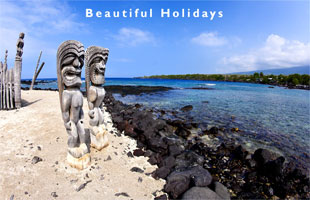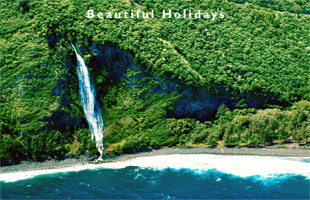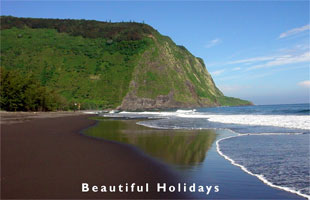Big Island Hawaii Holidays & Accommodation
Hawaii Islands, USA, North America

The Big Island of Hawaii is one of the few places in the world where you can get up close and personal with an active volcano. Not only that, you can explore the highlands of Kona, one of the best coffee growing regions in the world. Hawaii's Big Island has a lot to offer its visitors, so visit soon, because you never know when the volcanoes will stop erupting! Hawaii, known as the Big Island to avoid confusion, is the youngest island in the Hawaiian Island chain. Not only is it the youngest island in the chain, it is also still growing. Although all the islands in the chain are volcanic in origin, the Big Island is the most volcanically active of all the islands.
Big Island Hawaii Holidays Planner
The Big Island is the most climatologically diverse of all the islands, incorporating all but two of the world's climate regions, including rain forests, volcanic deserts, and snow-capped mountains. Here you will find the world-renown Hawaii Volcanoes National Park. At over 333 000 acres, this is the largest park in the island chain, and is perhaps the most spectacular of all the parks with its lava flows. There are plenty of other scenic vistas throughout the Big Island, from Rainbow Falls, to Kohala Mountain Road.
For affordable accommodation, may people choose the Kailua village of Kailua-Kona. Here you can explore the shopping of the main street of Alii Drive. Also in Kailua-Kona you can find the Hulihee Palace which was once a summer vacation home for Hawaiian royalty. Built in 1838, today it is a showcase for the Victorian antiquities it contains from the era of King Kalakaua and Queen Kapiolani. On the grounds of the King Kamehameha Kona Beach Hotel in town you can find the temple of Ahuena Heiau, commissioned by King Kamehameha himself, which is also on the register of National Historic Landmarks.
This small but picturesque town belies its size at night with a great night life, and visitors can enjoy live music while enjoying the view of Kailua Bay.
Hilo, once centre of the 1800's sugar industry on the island, is home to museums like the Tsunami Museum, the Imiloa Astronomy Center, art galleries, shops, orchid farms and the Liliukalani Gardens. Hilo has a dynamic history of destruction and rebuilding due to earthquakes, lava flows, and tsunamis, and many of the museums and cultural landmarks in the area commemorate these events and celebrate the spirit of rejuvenation that keeps the city rebuilding after disaster. Just outside town you can find the Wailuku River State Park where you can see the Rainbow Falls where on sunny days, rainbows dance in the spray at the bottom of the falls where the roiling waters are referred to as the Boiling Pots. Hilo makes an excellent place to stay for people wanting to explore the Hawaii Volcanoes National Park.
Inland from the Volcanoes Park on the Kohala Park is Waimea, which is Paniolo country. These cowboys are a recent addition to Hawaii's cultural tradition. A handful of sickly longhorn cattle were given to King Kamahameha I by Captain George Vancouver, and later ranchers imported the cowboy culture from Mexico. These highlands of the Big Island are home to some of the greenest pasture and ranches to be found in Hawaii, and you may choose to explore life here on a guest ranch for a unique holiday.
Hawaiian Volcanoes National Park is home to Kilauea, one of the most active volcanoes on earth, it is a sacred place for native Hawaiians, and you can find petroglyphs that are centuries old, over 23 000 of them at the coastal end of the Chain of Craters Road. As for Kilauea, it has been erupting constantly since 1983, adding an estimated 250 000-650 000 cubic yards of land to the island every day. One of the favourite things for visitors to do is watch the lava meet the ocean, and to do this, one of the best things to do is charter a boat for the best view. The park has over 150 miles of trails that take visitors through craters, and is home to the most massive mountain in the world, Maunaloa, a volcano which stopped erupting only recently in 1984.



